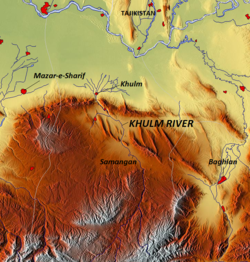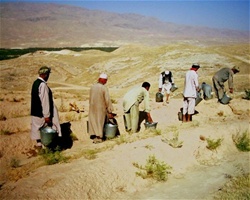Geography
The mountains are characterized as rocky aridity as they extend from the Koh-i-Baba to Khulm River. On occasion, the landscape turns into trenched valleys engulfed with vegetation. [3] The river rocks are composed of sandstone and limestone. [4]
The Khulm River is one of the tributaries of the Amu Darya River, a major river in Central Asia. It is known as a “blind river” or “natural river” as it dries up due to local use within its basin boundary and does not reach the Amu Darya, except during exceptional high flow years. The Khulm River originates in the Kara-Kotal pass and flows through gorges and then emerges into a wide valley near the Tashkurgan town. The river raising at an elevation of 3,600 m has a total length of about 230 km. It drains a catchment area of 8,400 km2 with the annual runoff estimates varying from 58.2 to 67 million m3 by different assessors. The road between Kabul and Mazar-e-Sharif follows the course of the river. [5] At the junction of the Bamian and Badakhshan routes, the Khulm River emerges from the mountains by the town of Kholm. [6]
The entire Khulm water is used up for irrigation before it can reach the Oxus. [3] In 1896, Keane wrote of the countryside's desert encroachment, causing the Khulm River as it passes from the Kara-koh hills to no longer reach the Oxus. [7]
This page is based on this
Wikipedia article Text is available under the
CC BY-SA 4.0 license; additional terms may apply.
Images, videos and audio are available under their respective licenses.




